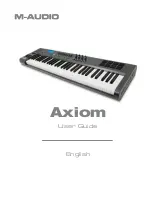
10-1
Style Record mode
The Style’s structure
1
0.
S
TYLE RECORD MODE
By entering the Style Record mode, you can create your own
Styles, or edit an existing Style.
THE
S
TYLE’
S
S
TRUCTURE
The term “Style” relates with music sequences automatically
played by the arranger of the Pa80. A Style consists of a pre-
defined number of
Style Elements (E)
(Pa80 features ten dif-
ferent Style Elements: Variation 1-4, Intro 1-2, Fill 1-2,
Ending 1-2). When playing, these Style Elements can be
selected directly from the control panel, using the corre-
sponding buttons.
To explain the Style structure, we can use a tree-structure, as
shown in the following diagram:
Each Style Element is made up of smaller units, called
Chord
Variations (CV),
but not all of them have the same number
of CVs. Variations 1-4 have up to 6 CVs each, while the other
Style Elements have only up to 2 CVs.
When you play on the chord recognition area (Lower, Upper
or Full, depending on the Chord Scanning section on the
control panel), the arranger scans the keyboard and deter-
mines which chord you are playing. Then, depending on the
selected Style Element, it determines which Chord Variation
(CV) should be played for the scanned chord. Which Chord
Variation corresponds to each scanned chord is a setting of
the Style: the
Chord Variation Table
. Each Style Element
contains a Chord Variation Table, whose prototype is the fol-
lowing:
After deciding what CV to play, the arranger triggers the right
sequence for each track. Since each sequence is written in a
particular key (for example, CMajor, GMajor or Emin), the
arranger transposes it according to the scanned chord. Notes
in the sequence are carefully transposed according to the
Note Transposition Tables (NTT)
, to make them work fine
with all recognized chords. The NTT allows you to record
just some Chord Variations, and have all the notes play in the
right place, avoiding dissonances and transposing the pattern
notes to the notes of the recognized chord.
Going deeper into the Style structure, we can see that each
Chord Variation is made up of
Track Sequences,
and the
Pa80 supports 8 different tracks. DRUM and PERC are used
for drum and percussion sequences, BASS for bass and
Pop Ballad
Variation 1
CV1
Drum
Perc
Bass
Acc1
Acc2
Acc3
Acc4
Acc5
CV2
CV3
CV4
CV5
CV6
Variation 2
Variation 3
Variation 4
Intro1
CV1
CV2
Intro 2
Fill 1
Fill 2
Ending 1
Ending 2
Chord
Chord Variations (CVs)
Variation
1
-4
Intro
1
-2, Fill
1
-2, Ending
1
-2
Maj
CV1 – CV6
CV1 – CV2
6
M7
M7b5
Sus4
Sus2
M7sus4
min
m6
m7
m7b5
mM7
7
7b5
7sus4
dim
dimM7
aug
aug7
augM7
no 3rd
no 3rd, no 5th
Summary of Contents for PA80
Page 1: ...USER S MANUAL ENGLISH Ver 3 06 MAN0001064 E ...
Page 10: ...TOC 6 ...
Page 11: ...INTRODUCTION ...
Page 12: ......
Page 28: ...4 4 Display and User Interface Grayed out non available parameters ...
Page 31: ...BASIC GUIDE ...
Page 32: ......
Page 38: ...6 6 Basic operations Shortcut to see the original bank for a Style Performance or Program ...
Page 46: ...7 8 Tutorial 6 The Arabic Scale ...
Page 51: ...REFERENCE GUIDE ...
Page 52: ......
Page 66: ...9 14 Style Play operating mode Page 25 Preferences controls ...
Page 150: ...15 10 Sampling operating mode The Write window ...
Page 181: ...APPENDIX ...
Page 182: ......
Page 218: ...19 32 Factory Data MIDI Setup ...
Page 270: ...20 52 Effects Mono Mono Chain ...
Page 274: ...21 4 Assignable parameters Scales ...
Page 280: ...23 4 Parameters ...
Page 288: ...25 6 Vocal Guitar Processor Board VHG1 Assembling the board without a HD drive installed ...
Page 292: ...26 4 Video Interface VIF1 Connections and setup ...
Page 300: ...28 6 Error messages Troubleshooting Troubleshooting ...
Page 302: ...29 2 Technical specifications ...
Page 306: ...30 4 Alphabetical Index ...
Page 307: ......
















































